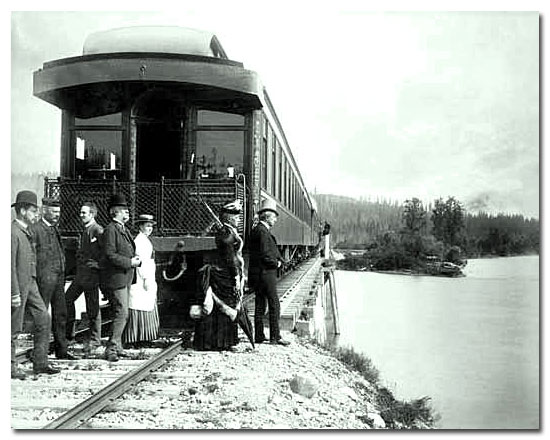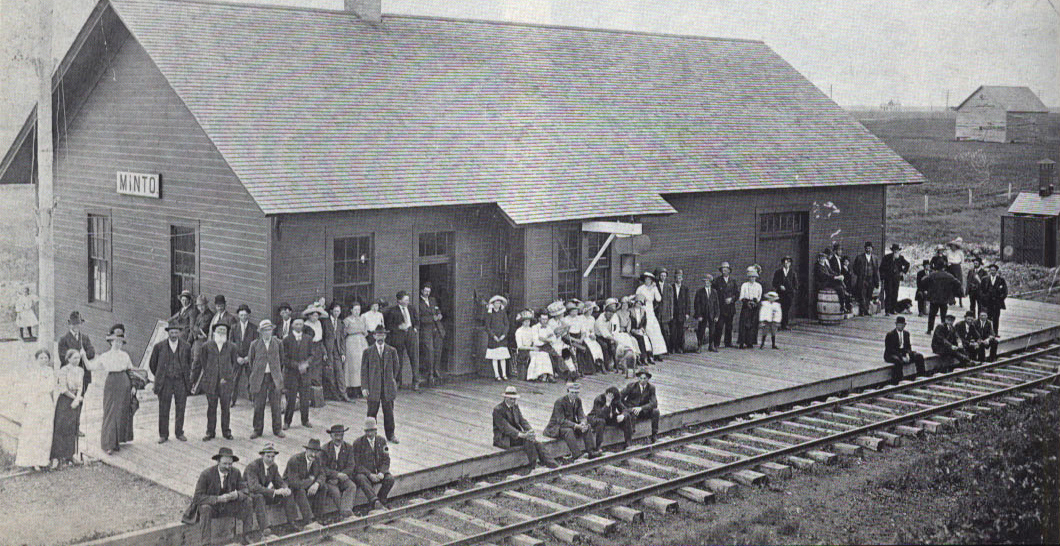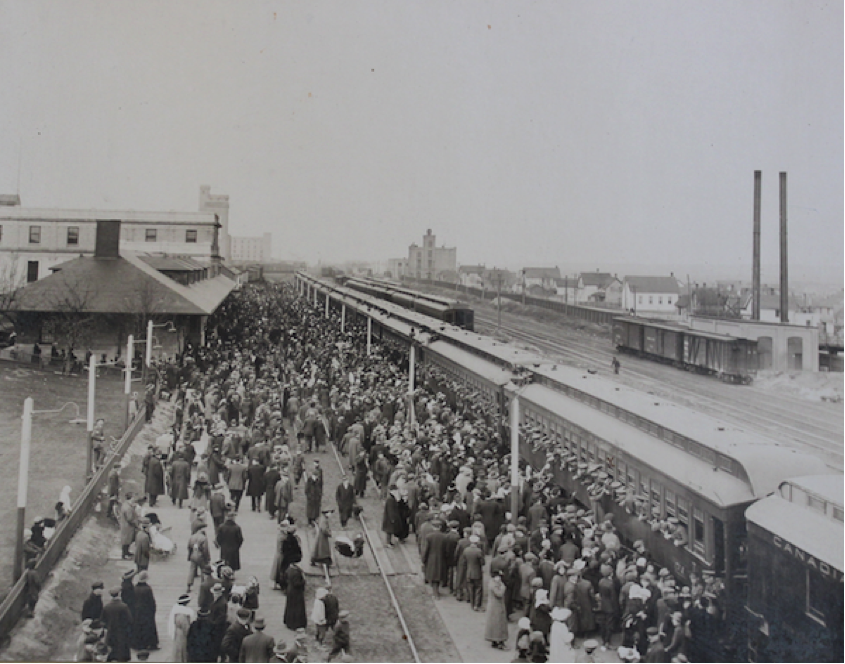Chapter
7: Dignitaries & Special Trains

The speed and
efficiency of rail travel changed everything in the new west. It
allowed politicians, businessmen, entertainers and even Royalty to
extend their reach and visit what just a few short years earlier had
been the inaccessible frontier.
Brandonites were
so enamoured with the idea of coast-to-coast travel that on Dominion
Day, July 1st 1886 the first transcontinental passenger train entered
the city to cheering crowd. Several excited passenger had walked to
Chater so they could board the train to say they were one of the
passengers on its inaugural arrival. Many stayed aboard to Oak Lake and
then traveled back on the next eastbound freight train.
After years of
political strife in the effort to see his dream and political promise
come to pass, John A. and Lady MacDonald made a well-publicized trip
west on the new CPR.
Their stop in
Brandon in late August 1886 was for just twelve hours. They were
honoured by the city of Brandon as the train pulled in, and were
welcomed on behalf of the community by Mayor Smart and other community
leaders.
At night
“thousands thronged the streets that were brightened by store windows
that had been especially decorated and illuminated for the
occasion”.
Then they quickly
moved on to the next stop. This was the only time John A. would cross
the country on the rails he had envisioned.
In 1887 a
celebratory jubilee train crossed the country in celebration of the
50th year of Queen Victoria’s reign. Although she didn’t tour Canada,
the admiration of royalty was strong in Canada and the decorated train
helped celebrate her reign across the land.
Going First Class
The 1890’s
represented a period when first-class railway travel meant precisely
that.
One could travel
in plush and paneled elegance.
Sleeping cars, a
popular innovation on medium-distance trains, were being built as fast
as the car builders could turn them out and travel on luxurious
transcontinental expresses promised pleasures never to be exceeded in
the decades to come. It was common for towns to greet the train’s
arrival after hearing the whistle in the distance. 'Train time" was a
welcomed daily event in which many stores closed their shops for the
arrival & departure of friends & family, and expected cargo.
One of the most
anticipated deliveries was the mail.
Before the
railway the mail often arrived by riverboat to one of the few post
offices of the area - Grand Valley. Return mail could take weeks.
It didn't take
long for Canadian government postal system to see the advantage of
"rail mail".
Time of delivery
was cut to days, in some cases hours.
Trains made it
possible to carry more mail and parcels quickly to nearly every city
and town in the west.
Over the decades,
politicians as diverse as Clifford Sifton and John Diefenbaker had easy
access to the outlying regions of the country.

The
MacDonalds,
touring Canada. Archives of Manitoba
The Royal Family
– then as now, were always welcome across the land. The train made it
happen.
There were
several Royal tours. In 1939 the CPR assigned 5 Hudson style
4-6-4 locomotives to the unprecedented royal tour of King George VI.
They were
impressive locomotives able to travel at speeds of 90 mph. They
featured with elaborate dining cars, sleeping cars and viewing
carriages. They even had a special car for the royal "butler" to steam
clean and press the clothing of King and Queen.
There were other
specialty service trains that arrived in Brandon over the years,
The Seed
Selection Special
One typically
prairie example was the Seed Selection Special, a wintertime highlight
for farmers. This train brought agricultural specialists to give
lectures and discuss the sustainabity of available strains of grain.
Later the
“Horticultural Show on Wheels” brought displays and a wider range of
information for farmers and homeowners. The staff lived right on the
train.
Fair Excursions
The Brandon Fair
was one of many ways in which Brandon acted as the economic and
cultural centre of Westman. Railway lines often offered special trains
to and from the city for special occasions. Crowds like this group from
Minto found it very convenient.

Photo
from the
Minto History
Through the
summer both CN & CP offered special Picnic Trains for the railway
families as well as the public. A decorated a train made day-trip
excursions to nearby towns. Neepawa, Souris and Virden were popular
destinations.
Troop Trains
In times of war
the speed and flexibility offered by our rapidly developing train
system was put to full advantage.
In the spring of
1885 a special train carrying two companies of the 90th Battalion were
welcomed as they stopped in Brandon. This was the first of many
troop trains as the new rail line was quickly put to military use.
Through the Riel Uprising, the Boer War and subsequent World Wars, the
departure and passing of troop trains was an occasion for emotional and
patriotic displays.
In World War 1
alone over 5000 troops from this area passed though on special troop
trains.
Troops departing
from A4 Royal Canadian Artillery Training Centre Headquarters at the
old Brandon Normal School on Queens Street and the Recruitment Centre
at the Brandon Armoury were always sent of by appreciative crowds.

A photo
of the
26th Field Regiment RCA - XII Manitoba Dragoons shows a typical scene –
a battalion departing form Brandon. Archives of Manitoba
Horses were also
frequent passengers. Brandon had a reputation as the Horse Capital of
the west and a May 3, Brandon Sun article proclaimed that over 1500
horses per month would be trained here for service at the front and
sent overseas never to return.
The
transportation of war materials was another important task. By 1915
Manitoba Engines Limited located on the corner 8th St. and Assiniboine
Ave was producing engines but switched to manufacturing 18
pounder and 4.5 inch howitzer shells for the war effort.
Just as our train
system made this diversification of war materials manufacture possible
– it also allowed a similar diversification of troop training centres.
Both men and
equipment could be moved at will.
World War II saw
even greater use of the railway in the war effort. After
struggling through the depression years the CN & CP were not
prepared for the sudden increased need for cargo & passenger cars.
Government support helped build the additional capacity to
handle 307 million tons of freight and 86 million passengers,
including 280,000 military personnel over the war years.
And of course
while in Brandon or Shilo special trains ran out to Camp Hughes for
Holiday celebrations and on election days made the stay a bit more
bearable.
|


